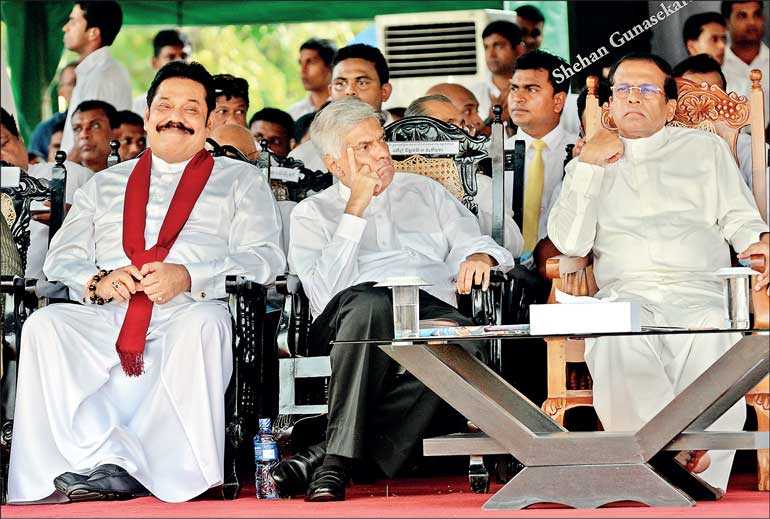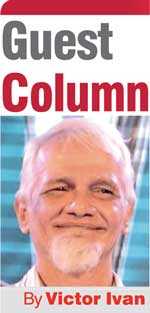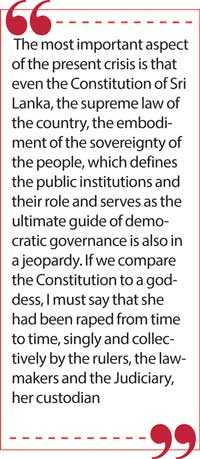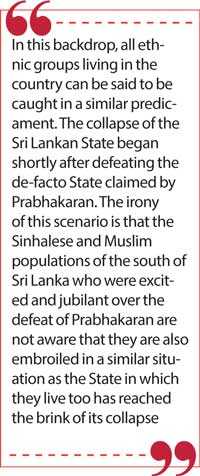Monday Mar 03, 2025
Monday Mar 03, 2025
Friday, 30 November 2018 00:00 - - {{hitsCtrl.values.hits}}

Presently, the Sri Lankan State has lost its dignified existence and the prowess that a state ought to have. Evidently, it is moving towards a virtual collapse. This, in my opinion is a direct outcome of the rotten state of affairs associated with the present Sri Lankan State and its putrid system of institutions replete with rampant corruption. 
The most important aspect of the present crisis is that even the Constitution of Sri Lanka, the supreme law of the country, the embodiment of the sovereignty of the people, which defines the public institutions and their role and serves as the ultimate guide of democratic governance is also in a jeopardy.
If we compare the Constitution to a goddess, I must say that she had been raped from time to time, singly and collectively by the rulers, the lawmakers and the Judiciary, her custodian. Consequently, she had been rendered innocent and inglorious. Presently, Sri Lanka is in a state of complete anarchy without having anyone to guide the rulers thereby expediting the downfall of the country.
The present situation of the south of Sri Lanka is more or less similar to the unfortunate conditions that prevailed in the north in the immediate aftermath of the internal civil war. At the end of the war, the Tamil north, from a political sense remained in a deranged state having lost many things. The Sinhalese south is also plunged into a similar situation consequent to the present constitutional crisis though there are certain differences in the nature of the circumstance.
In this backdrop, all ethnic groups living in the country can be said to be caught in a similar predicament. The collapse of the Sri Lankan State began shortly after defeating the de-facto State claimed by Prabhakaran. The irony of this scenario is that the Sinhalese and Muslim populations of the south of Sri Lanka who were excited and jubilant over the defeat of Prabhakaran are not aware that they are also embroiled in a similar situation as the State in which they live too has reached the brink of its collapse.
Destruction caused by violence
The violent struggles in the Sinhalese south and the Tamil north resulted in untold damage to the country. The Sinhalese rebels attempted to capture the ruling power while Tamil rebels aimed at establishing a separate state of their own; ultimately, what both did was to attack the State.
Even though the government in power was able to suppress and defeat the armed rebels, their attacks on government necessarily resulted in weakening and devastating the country. Both Sinhalese and Tamil rebels exerted maximum violence and cruelty. In subduing them, the State as an alternative counter strategy released more violence and cruelty than was exerted by the rebels. Both the rebels and the government acted in violation of the law during this long uncivilised period, giving way to the reign of the law of the jungle which invariably led to blotch the integrity of the State, politicians and the officialdom. It became pervasive in almost every sphere with everyone becoming interested only in himself. 
Exploitation of State property by its custodians became the norm of the State rule during this uncivilised period. The face of the State underwent a repulsive transformation giving it a look of an exploitative band of thieves. The violent struggles distorted and weakened the institutional system of the country.
Similarly, the very foundation of the State itself was threatened, distorted and weakened. While a substantial number of unfortunate people had been physically killed in violent struggles, those escaped death and were fortunate to survive had to suffer a spiritual death. Thus, to a greater or lesser degree the entire society had been plunged into a spiritual death.
After ending the civil war, the successive governments that came to power should have made an honest attempt to probe into the circumstances that led to the armed struggles, violence and the resultant destruction with the view to rebuilding the State which was rampant with injustice, inefficiency and corruption and also to recreate the society which had been rendered sick.
But, Mahinda Rajapaksa, the leader who ended the war, and the two main leaders of the Yahapalana Government, Maithripala Sirisena and Ranil Wickremesinghe, who succeeded the former defeating him, lacked the wisdom and the courage required for that. Consequently, the country has fallen out of the frying pan into the fire.
Failure to build the modern nation state prior to or after independence can be considered the main cause of the Sri Lanka’s crisis. The true meaning of building the nation state implies negation of ethnic, caste and religious differences and treating everyone with equal respect, ensuring equal rights for everyone thereby creating a nation with a common identity as Sri Lankans who are bound by a common bond and committed to work in harmony for the upliftment of the country.
India and Singapore are two countries that had achieved this object successfully. India did it in a formal way. Singapore achieved it in a different style. Our earlier leaders (Ponnambalam Arunachalam, D.S. Senanayake and S.W.R.D. Bandaranaike) and those emerged later did not have a deep political knowledge on this problem. Instead, their thinking had been shaped by the factors of race, caste and religion.
Role of the caste
Mahatma Gandhi came to Sri Lanka on a 17-day visit on 12 November 1927. Gandhi’s visit coincided with the arrival of the members of the Donoughmore Commission which proposed Constitutional reforms to formulate a system of government for Ceylon (Sri Lanka).
Mahatma Gandhi delivered a short speech at the reception organised on the same day by the Lanka Jathika Sangamaya at Maligakanda Pirivena to welcome him. The speech he made addressing the leaders of the Jathika Sangamaya is produced in the book titled ‘Gandhi in Sri Lanka’ written by Gopal Krishna. But it does not contain a list of names of those who participated in this meeting.
However, Sampath Bandara, in his book titled ‘Mahatma Gandhige Lanka Gamanaya haa Lankeeya Deshapalanaya’ (Arrival of Mahatma Gandhi in Sri Lanka and Sri Lankan Politics) has included a list of leaders who were present to welcome Gandhi. E. W.Perera, the President of Lanka Jathika Sangamaya, D.B.Jayathilaka, James Peiris, Victor Korea, and W.A.de.Silva, F.R.Obesekara, SWRD Bandaranaike and D.S.Senanayaka were among many others who were present at this meeting. We can safely presume that all important leaders of the Lanka Jathika Sangamaya might have attended this meeting.
Gandhi used the word “freedom” referring to the Independent Movements of both India and Ceylon at this meeting. But he was careful in qualifying that they were not the same but two different movements. He raised a very important question, a principle in regard to the freedom or independence that Sri Lanka was aspiring to gain.
Gandhi, addressing them had said that “there exists a community considered as ‘untouchables’ in India. Though I have no clear idea about the social life in Lanka, I have heard of a similar community in Lanka known as Rodiyas treated as untouchables and questioned whether the Lanka Jathika Sangamaya expects to ensure the freedom of such suppressed groups in its campaign for freedom. If the freedom of suppressed groups is not ensured then the freedom that you aspire to gain cannot be considered true and genuine.”
I do not think that the leaders of the Jathika Sangamaya were capable of grasping the deep political meaning underneath this statement. Gandhi called the untouchables the Harijans which means the sons of God!
As stated in ‘Caste in Modern Ceylon’ by Bryce Ryan, an authoritative account on caste system in Sri Lanka, “towards the end of the nineteenth century and until 1925 or so, some of the bitterest fulminations in Ceylon were not inter-communal but inter-caste”. In the passage of time the open castes conflicts had subsided while the ethnic differences had taken its place. Yet, the roots of caste animosity have not disappeared. They remain latent in the social fabric. 
B.H. Farmer in his book titled ‘Ceylon – A Divided Nation’ provides a detailed account of the historical evolution of social conflicts in Sri Lanka and the circumstances that led to them. He had emphasised that the caste factor still persists as a formidable force in Sri Lanka’s politics. Interestingly, Farmer had written this book in 1963, 15 years after the country had gained independence.
The leaders of minorities viewed with suspicion the independence that was going to be conferred on Sri Lanka without a strong social struggle being made on the part of the beneficiaries. The leaders of minorities had a fear that they will be overwhelmed by a Sinhalese domination once the British rule was over. Similarly, the leaders of the suppressed castes in both the Sinhalese and the Tamil society had a fear that they would be dominated by the Sinhalese Goigama and Tamil Vellala castes respectively. These two groups of suppressed castes made separate submissions first to the Donoughmore Commission and later to the Soulbury Commission seeking redress for their grievances.
Prior to gaining independence the pressure stood on caste and not on ethnicity. As Gandhi had instinctively felt during his tour of Sri Lanka, the independence has not become a political phenomenon guaranteeing freedom to the suppressed castes. It did not pave the way for the people who served as serfs in temple and manor lands to come out of the wretchedness associated with their lives.
As a result, the independence could not make a far-reaching impact on the life of the oppressed classes who had been denied human respect and human rights owing to the deep rooted caste discriminations that prevailed in both Sinhalese and Tamil society .
Nationalism
The Donoughmore Commission too, which arrived in Sri Lanka on the day Mahatma Gandhi’s visit took place, had made important observations on nationalism and democracy practiced in the country. Its observations are valid even today.
The Donoughmore Commission observed that Sri Lanka had not yet evolved into a cohesive society; nationalism which had developed was only an ad-hoc outgrowth of race, caste and religion and was not aimed at common welfare of the country and the people; the society lacked democratic disciplines or a system of political parties for successful operation of a parliamentary system of government.
The Donoughmore Commission had further stated that there was no unity or sense of collective responsibility among the leaders and as such, at this moment, the country should be granted only a system of governance which could help promote unity, national cohesion and raise social awareness on democracy.
All frontline national leaders of the day like Ponnambalam Ramanadan, D.S. Senanayake and S.W.R.D. Bandaranaike had thoroughly opposed the grant of universal suffrage to the people of Sri Lanka. Ostensibly, their views and biases on social classes and the caste system had an impact on their protest.
However; the Donoughmore Commission was of the view that most of the regressive social elements would slowly disappear once the universal suffrage was introduced. The commission introduced a special system of governance based on a Committee System to educate the political leaders of the country, instil discipline in them to overcome parochial differences and encourage them to work in harmony and democratically.
Role of ethnicity
It was after gaining independence that the ethnic issue came to forefront. In my opinion, it was S.W.R.D. Bandaranaike who aggravated the ethnic difference between Sinhalese and Tamils and mystified it into a complex issue which eventually culminated in a ruthless bloodshed. It’s a fact that the vernaculars suffered badly during the colonial regime. Local languages had lost recognition and restoring their status remained an essential condition. Bandaranaike achieved his political dream with the support of the proponents of the Sinhala Only policy. In this respect, Tamils can be considered a community more passionate and attached to their language than Sinhalese people.

What ought to have been done was to give a new and renewed recognition for both languages, Sinhala and Tamil and adopt a bilingual policy allowing the Sinhalese people to transact with the government in Sinhala language and Tamils in Tamil language while English is promoted as the second language in schools. Yet, what Bandaranaike did was to throw the English language into the waste bin and disallow Tamil people of their right to transact with the government in their language, thereby denying them the respect they enjoyed as human beings.
Ethnicity and caste remained two crucial factors that caused violent attacks and bloodshed in Sri Lanka. It was Sinhalese youth in the south who took arms first against the government and not the Tamils in the north. According to the observations made by the public authorities on the 1971 insurrection, it was not only a class struggle, even the caste has had a big impact on it. That was why the authorities were prompted to look into the caste background of all rebels who were arrested. Perhaps, this must be the first instance in which a research had been done about the caste.
President Ranasinghe Premadasa, following the defeat of the second JVP insurrection, appointed a commission of inquiry to probe into the youth unrest and report the reasons that had led to insurrections .The Commission on Youth Unrest too had observed the impact of caste on youth unrest in both in the south and the north. The violent uprisings broke out at different times had a destructive impact on the State and the society. They were instrumental in distorting and making the society sick and above all rendering the State corrupt and weak. It was an outcome of the failure on our part to build the modern nation at independence or thereafter. Sri Lanka has no capacity to move forward, even one step ahead without recreating the nation.
Even after a great catastrophe, it would still be possible, though late, to recreate the nation provided we are ready to thrust aside ethnic, caste and religious differences and adopt a policy of treating everyone equally irrespective of discriminatory practices and prejudices. The State which had reached the verge of collapse can still be restored only if we are capable of recreating the nation.
Discover Kapruka, the leading online shopping platform in Sri Lanka, where you can conveniently send Gifts and Flowers to your loved ones for any event including Valentine ’s Day. Explore a wide range of popular Shopping Categories on Kapruka, including Toys, Groceries, Electronics, Birthday Cakes, Fruits, Chocolates, Flower Bouquets, Clothing, Watches, Lingerie, Gift Sets and Jewellery. Also if you’re interested in selling with Kapruka, Partner Central by Kapruka is the best solution to start with. Moreover, through Kapruka Global Shop, you can also enjoy the convenience of purchasing products from renowned platforms like Amazon and eBay and have them delivered to Sri Lanka.
Discover Kapruka, the leading online shopping platform in Sri Lanka, where you can conveniently send Gifts and Flowers to your loved ones for any event including Valentine ’s Day. Explore a wide range of popular Shopping Categories on Kapruka, including Toys, Groceries, Electronics, Birthday Cakes, Fruits, Chocolates, Flower Bouquets, Clothing, Watches, Lingerie, Gift Sets and Jewellery. Also if you’re interested in selling with Kapruka, Partner Central by Kapruka is the best solution to start with. Moreover, through Kapruka Global Shop, you can also enjoy the convenience of purchasing products from renowned platforms like Amazon and eBay and have them delivered to Sri Lanka.